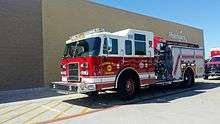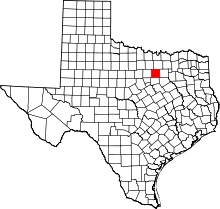Richland Hills, Texas
| Richland Hills, Texas | |
|---|---|
| City | |
| City of Richland Hills | |
 Location of Richland Hills in Tarrant County, Texas | |
| Coordinates: 32°48′36″N 97°13′35″W / 32.81000°N 97.22639°WCoordinates: 32°48′36″N 97°13′35″W / 32.81000°N 97.22639°W | |
| Country |
|
| State |
|
| County |
|
| Incorporated | 1950 |
| Government | |
| • Type | Council-Manager |
| • City Council |
Mayor Bill Agan Place 1 - Roland Goveas Place 2 - Allison Barrette Place 3 - Robert DeSoto Place 4 - Beverly Williams Place 5 - Edward Lopez |
| • City Manager | Eric Strong |
| • Mayor Pro Tem | Edward Lopez |
| Area | |
| • Total | 3.2 sq mi (8.2 km2) |
| • Land | 3.1 sq mi (8.1 km2) |
| • Water | 0 sq mi (0 km2) |
| Elevation | 568 ft (173 m) |
| Population (2010) | |
| • Total | 7,801 |
| • Density | 2,400/sq mi (950/km2) |
| Time zone | CST (UTC-6) |
| • Summer (DST) | CDT (UTC-5) |
| ZIP codes | 76118 |
| Area code(s) | 817 |
| FIPS code | 48-61844[1] |
| GNIS feature ID | 1375731[2] |
| Website | http://www.richlandhills.com/ |
Richland Hills is a city in Tarrant County, Texas, United States. The population was 7,801 at the 2010 census.[3]
Geography
Richland Hills is located at 32°48′36″N 97°13′35″W / 32.81000°N 97.22639°W (32.810080, -97.226369).[4]
According to the United States Census Bureau, the city has a total area of 3.2 square miles (8.2 km²), all of it land.
Demographics
| Historical population | |||
|---|---|---|---|
| Census | Pop. | %± | |
| 1960 | 7,804 | — | |
| 1970 | 8,865 | 13.6% | |
| 1980 | 7,977 | −10.0% | |
| 1990 | 7,978 | 0.0% | |
| 2000 | 8,132 | 1.9% | |
| 2010 | 7,801 | −4.1% | |
| Est. 2016 | 8,121 | [5] | 4.1% |
As of the census[1] of 2000, there were 8,132 people, 3,197 households, and 2,196 families residing in the city. The population density was 2,584.6 people per square mile (996.8/km²). There were 3,334 housing units at an average density of 1,059.6 per square mile (408.7/km²). The racial makeup of the city was 90.41% White, 1.44% African American, 0.61% Native American, 1.01% Asian, 0.27% Pacific Islander, 4.06% from other races, and 2.20% from two or more races. Hispanic or Latino of any race were 10.15% of the population.
There were 3,197 households out of which 29.7% had children under the age of 18 living with them, 52.9% were married couples living together, 11.5% had a female householder with no husband present, and 31.3% were non-families. 26.4% of all households were made up of individuals and 12.0% had someone living alone who was 65 years of age or older. The average household size was 2.47 and the average family size was 2.99.
In the city, the population was spread out with 23.6% under the age of 18, 7.1% from 18 to 24, 27.4% from 25 to 44, 21.7% from 45 to 64, and 20.2% who were 65 years of age or older. The median age was 40 years. For every 100 females there were 85.9 males. For every 100 females age 18 and over, there were 83.2 males.
The median income for a household in the city was $43,377, and the median income for a family was $50,377. Males had a median income of $35,635 versus $28,066 for females. The per capita income for the city was $20,247. About 3.9% of families and 5.8% of the population were below the poverty line, including 8.2% of those under age 18 and 3.1% of those age 65 or over.
Education
The City of Richland Hills is served by the Birdville Independent School District, while most of the southern part is served by Fort Worth Independent School District.
Transportation
Roads
3 State Highways pass through Richland Hills -
- Texas State Highway 183 (Baker Boulevard)
- Texas State Highway 121 (Airport Freeway)
- Texas State Highway 26 (Boulevard 26 / Grapevine Highway)
Public transportation
The City of Richland Hills is served by Mobility Impaired Transportation Service (MITS) and the Richland Hills Station on the Trinity Railway Express commuter rail line.
Culture
Arts and sciences
- Nature
Richland Hills is listed with the Texas Historical Commission as being a City on the Texas Lakes Trail.
- Retail
There are no shopping malls in Richland Hills, however a regional complex, North East Mall in Hurst, TX serves most of the Mid-Cities and Northeastern Tarrant County.
Parks and recreation

There are 4 parks in Richland Hills -
- Kate Baker Park - 3555 Vance Rd.
- Rosebud Park - 2600 Rosebud Ln.
- Creek Trail Park - 3925 Airline Dr.
- Windmill Park - 6936 Park Place Dr.
References
- 1 2 "American FactFinder". United States Census Bureau. Retrieved 2008-01-31.
- ↑ "US Board on Geographic Names". United States Geological Survey. 2007-10-25. Retrieved 2008-01-31.
- ↑ "Profile of General Population and Housing Characteristics: 2010 Demographic Profile Data (DP-1): Richland Hills city, Texas". U.S. Census Bureau, American Factfinder. Archived from the original on September 11, 2013. Retrieved December 1, 2011.
- ↑ "US Gazetteer files: 2010, 2000, and 1990". United States Census Bureau. 2011-02-12. Retrieved 2011-04-23.
- ↑ "Population and Housing Unit Estimates". Retrieved June 9, 2017.
- ↑ "Census of Population and Housing". Census.gov. Archived from the original on May 11, 2015. Retrieved June 4, 2015.


